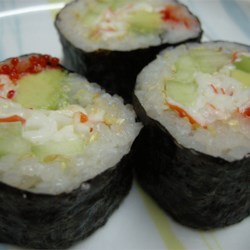Asian Cuisine
A Few Good Things
(Click the food titles for recipes if you wish.)Potstickers
Jiǎozi (simplified Chinese: 饺子; traditional Chinese: 餃子; Japanese: gyōza; Vietnamese: bánh chẻo; Nepali: म:म: or ममचा) or pot sticker is a Chinese dumpling widely spread to Japan, Eastern and Western Asia.Jiaozi typically consist of a ground meat and/or vegetable filling wrapped into a thinly rolled piece of dough, which is then sealed by pressing the edges together or by crimping. Jiaozi should not be confused with wonton; jiaozi has a thicker skin and a relatively flatter, more oblate, double-saucer like shape (similar in shape to ravioli), and is usually eaten with a soy-vinegar dipping sauce (and/or hot chili sauce); while wontons have thinner skin, are rounder, and are usually served in broth. The dough for the jiaozi and wonton wrapper also consist of different ingredients.
Sushi

Sushi (すし, 寿司, 鮨, 鮓, 寿斗, 寿し, 壽司?) is a Japanese food consisting of cooked vinegared rice (shari) combined with other ingredients (neta). Neta and forms of sushi presentation vary, but the ingredient which all sushi have in common is shari. The most common neta is seafood.
Raw meat sliced and served by itself is sashimi.
Pak kanaa moo krob
Thai style stir fried Chinese broccoli (pak kana, Thai: ผักคะน้า) with crispy pork (mu krop Thai: หมูกรอบ). The recipe also includes sliced large red chillies, sliced garlic, oyster sauce and soy sauce. Here it is served rat khao, meaning "together with rice".
Pocky
Pocky (ポッキー Pokkī?, Japanese pronunciation: [pokːiː] (The original was followed by "Almond Pocky" in 1971, with an almond coating, and "Strawberry Pocky" in 1977. Today, the product line includes such variations as milk, mousse, green tea, honey, banana and coconut flavored coatings, and themed products such as "Decorer Pocky," with colorful decorative stripes in the coating, and "Men's Pocky," a dark (bittersweet) chocolate and "mature" version.

Khao Phat Kung
Thai fried rice (Thai: ข้าวผัด, RTGS: khao phat, pronounced [kʰâːw pʰàt] or [kʰâw pʰàt]) is a variety of Fried rice typical of central Thai cuisine. In Thai, khao means "rice" and pad means "of or relating to being stir-fried". This dish differs from Chinese fried rice is that it is prepared with Thai Jasmine rice instead of regular long-grain rice. It normally contains a meat (chicken, shrimp, and crab are all common), egg, onions, and tomatoes. Green onions, coriander, and fried garlic are then mixed in. This dish has many regional variants, as it is a widespread dish. Then seasonings are stirred in, which may include soy sauce, sugar, salt, possibly some chili sauce, and the ubiquitous nam pla (fish sauce). Then the dish is plated and served with accompaniments like cucumber slices, tomato slices, lime and sprigs of green onion.Other dishes include Coconut Fried Rice (Thai: ข้าวผัดมะพร้าว, khao phat maphrao), Pineapple Fried Rice (Thai: ข้าวผัดสับปะรด, khao phat sapparot) and Basil Fried Rice (Thai: ข้าวผัดกระเพรา, khao phat kraphao). Khao op sapparot is a fancier fried rice pineapple dish with raisins and nuts and almost always comes served inside a cutout pineapple.
Common variants:
Khao phat mu, pork fried rice.
Khao phat kai, chicken fried rice.
Khao phat kung, shrimp fried rice.
Khao phat pu, crab fried rice.
Khao phat khai, egg fried rice.
All are very good. I wouldn't advertise it if it was bad. If you try it and don't like it it just wasn't you. There are plenty of dishes out there. Be daring but don't try anything you are allergic to or were told not to eat by a doctor.
No comments:
Post a Comment